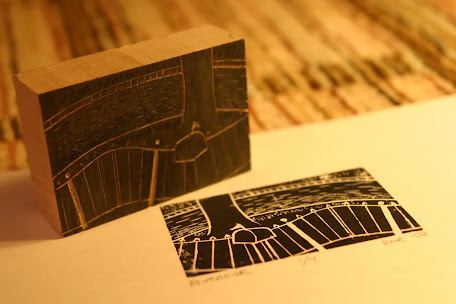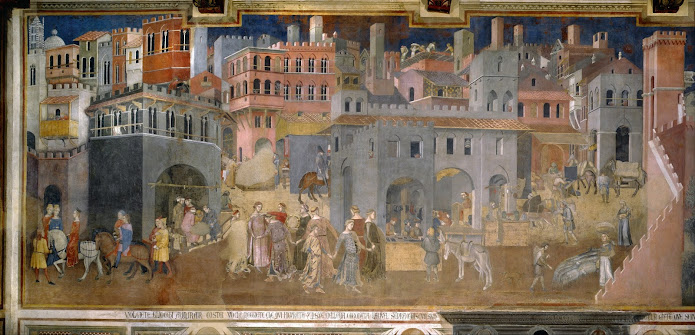Non Western - Ukiyo-e
Ukiyo-e
Ukiyo-e is a type of Japanese art, and the ones we are looking at today are made from blocks of wood. When making a piece like this, the drawing is done first on paper, and is then used as an outline to chisel away at a block of wood where it is then painted. This is an interesting technique, and it basically makes the wood a stamp. The Ukiyo-e movement went on from the 17th - 19th century in Japan and while it had a lot of diversity, there are similar characteristics in a lot of the work. I will be showcasing three artists and one woodblock print from each one.
 |
| Small woodblock print |
The fist artist we will look at is Utagawa Hiroshige and the work titled Meguro From Bridge and Sunset Hill, No. 111 from One Hundred Famous Views of Edo. This was made in 1857, and was showing a place in what's now known as Meguro City.
 |
| Meguro From Bridge and Sunset Hill |
As you can see, the work isn't anything too special, but it's the bridge, one of the main subjects that make this a more significant scene. Rounded bridges like this were uncommon at this time, especially ones made of stone, so this was showing how advanced Meguro's architecture had become, at least at this spot! I really enjoy this piece, and the style as a whole, I think one of the aspects that interests me about it, is how simple a lot of the scenes are, and how the artist captures the atmosphere so well.
I really like the winter scenery, and the shape of the piece really allows the eye to naturally take on each aspect of it. When it comes to any sort of artistic elements that go into this style, the mechanics differ from a normal painting, as it's not only a painting, but a carving too. Having a keen sense of proportions, lines, shape, and all that is vital in any painting and this just steps it all up.
 |
| Cushion Pine at Aoyama |
This next woodblock print is titled Cushion Pine at Aoyama, from the series Thirty-six Views of Mount Fuji by Katsushika Hokusai. This was made in 1830 and is 9 5/8 x 14 3/4 in. This beautiful landscape shows men having a picnic in a garden path, looking over at Mt. Fuji, with the vast land in-between them hiding under the clouds. The color palette is one I like a lot, and the way the space is filled is also very appealing to me. This landscape style and almost haze like look was common in a lot of Hokusai's work.
The way the mountain looms in the distance, and the trail of green trees pulls the eye to it, makes this a mysterious scene, really giving you a feel for how great the mountains are. Some elements that are key in this, are space, shading, and color. All three work together to make this such a nice looking piece.
 |
| Geisha and Maid Carrying a Shamisen Box |
The third and final woodblock print I will be going over is titled Geisha and Maid Carrying a Shamisen Box, by Kitao Shigemasa. This was made in 1777, and is on exhibit at the Scholten Japanese Art museum in New York. I chose this piece as it shows a different look from the other two, yet still provides that signature woodblock look. We see two women, one of which carrying a shamisen box who is a maid, the woman on the left is a geisha, a performing artist who in this case, plays a shamisen, which is a banjo like instrument. This shows off another side of ukiyo-e art, being there were often woodblocks of women who were very attractive by that times beauty standard.
I like this piece as there are so many fine details, from the embroidery work on the clothes, to the shoes and hair. Another thing I like about this style, is the minimal background, there isn't some over the top design in the back to draw the ye away. Some essential elements in this would have to be color and lines as this style relies on line work, and the colors give it a fresh look.
References
Kitao SHIGEMASA: Geisha and Maid Carrying A Shamisen Box (Ca. 1777). www.artsy.net/artwork/kitao-shigemasa-geisha-and-maid-carrying-a-shamisen-box.
Metmuseum.org. www.metmuseum.org/art/collection/search/56388.
Poem by Jito Tenno. www.roningallery.com/artists/Hokusai.
Ukiyo-e. 18 Apr. 2021, en.wikipedia.org/wiki/Ukiyo-e.



I love the Japanese art. I was born in Japan (though I am not ethnically Japanese). Because of this most Japanese art interests me. My personal favorite is the woodblock prints. They require a lot of skill, not to mention carving it inverted so that the image would show the correct way.
ReplyDelete